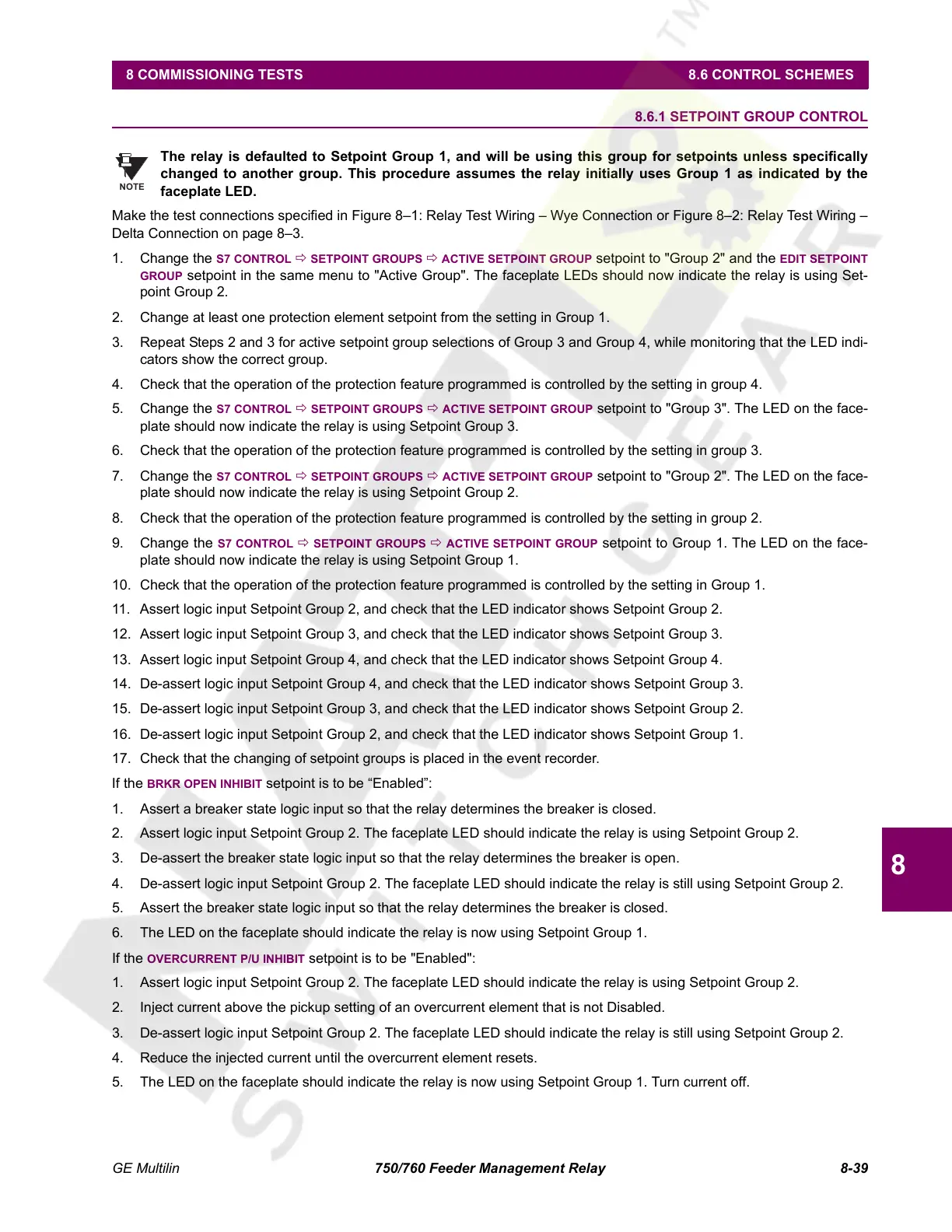GE Multilin 750/760 Feeder Management Relay 8-39
8 COMMISSIONING TESTS 8.6 CONTROL SCHEMES
8
8.6CONTROL SCHEMES 8.6.1 SETPOINT GROUP CONTROL
The relay is defaulted to Setpoint Group 1, and will be using this group for setpoints unless specifically
changed to another group. This procedure assumes the relay initially uses Group 1 as indicated by the
faceplate LED.
Make the test connections specified in Figure 8–1: Relay Test Wiring – Wye Connection or Figure 8–2: Relay Test Wiring –
Delta Connection on page 8–3.
1. Change the
S7 CONTROL Ö SETPOINT GROUPS Ö ACTIVE SETPOINT GROUP setpoint to "Group 2" and the EDIT SETPOINT
GROUP setpoint in the same menu to "Active Group". The faceplate LEDs should now indicate the relay is using Set-
point Group 2.
2. Change at least one protection element setpoint from the setting in Group 1.
3. Repeat Steps 2 and 3 for active setpoint group selections of Group 3 and Group 4, while monitoring that the LED indi-
cators show the correct group.
4. Check that the operation of the protection feature programmed is controlled by the setting in group 4.
5. Change the
S7 CONTROL Ö SETPOINT GROUPS Ö ACTIVE SETPOINT GROUP setpoint to "Group 3". The LED on the face-
plate should now indicate the relay is using Setpoint Group 3.
6. Check that the operation of the protection feature programmed is controlled by the setting in group 3.
7. Change the S7 CONTROL Ö SETPOINT GROUPS Ö ACTIVE SETPOINT GROUP setpoint to "Group 2". The LED on the face-
plate should now indicate the relay is using Setpoint Group 2.
8. Check that the operation of the protection feature programmed is controlled by the setting in group 2.
9. Change the S7 CONTROL Ö SETPOINT GROUPS Ö ACTIVE SETPOINT GROUP setpoint to Group 1. The LED on the face-
plate should now indicate the relay is using Setpoint Group 1.
10. Check that the operation of the protection feature programmed is controlled by the setting in Group 1.
11. Assert logic input Setpoint Group 2, and check that the LED indicator shows Setpoint Group 2.
12. Assert logic input Setpoint Group 3, and check that the LED indicator shows Setpoint Group 3.
13. Assert logic input Setpoint Group 4, and check that the LED indicator shows Setpoint Group 4.
14. De-assert logic input Setpoint Group 4, and check that the LED indicator shows Setpoint Group 3.
15. De-assert logic input Setpoint Group 3, and check that the LED indicator shows Setpoint Group 2.
16. De-assert logic input Setpoint Group 2, and check that the LED indicator shows Setpoint Group 1.
17. Check that the changing of setpoint groups is placed in the event recorder.
If the
BRKR OPEN INHIBIT setpoint is to be “Enabled”:
1. Assert a breaker state logic input so that the relay determines the breaker is closed.
2. Assert logic input Setpoint Group 2. The faceplate LED should indicate the relay is using Setpoint Group 2.
3. De-assert the breaker state logic input so that the relay determines the breaker is open.
4. De-assert logic input Setpoint Group 2. The faceplate LED should indicate the relay is still using Setpoint Group 2.
5. Assert the breaker state logic input so that the relay determines the breaker is closed.
6. The LED on the faceplate should indicate the relay is now using Setpoint Group 1.
If the
OVERCURRENT P/U INHIBIT setpoint is to be "Enabled":
1. Assert logic input Setpoint Group 2. The faceplate LED should indicate the relay is using Setpoint Group 2.
2. Inject current above the pickup setting of an overcurrent element that is not Disabled.
3. De-assert logic input Setpoint Group 2. The faceplate LED should indicate the relay is still using Setpoint Group 2.
4. Reduce the injected current until the overcurrent element resets.
5. The LED on the faceplate should indicate the relay is now using Setpoint Group 1. Turn current off.
NOTE
Courtesy of NationalSwitchgear.com

